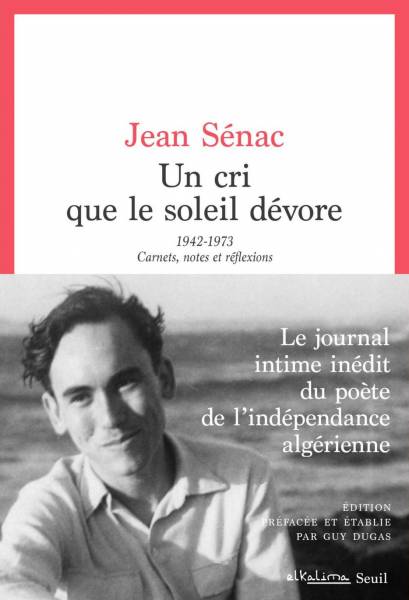Fiche Personne
Littérature / édition
Interculturel/Migrations
Poésie / Conte
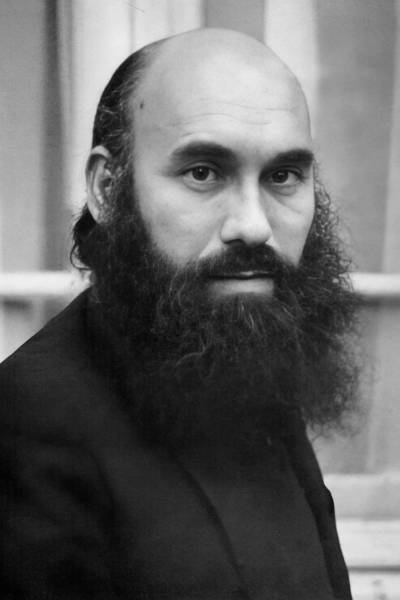 ©
©
Jean Sénac (جان سيناك)
Ecrivain/ne, Poète, Militant/e
(Homme)
Algérie, France
 ©
©
Français
Jean Sénac, né à Béni-Saf en Oranie en Algérie, le 29 novembre 1926 et assassiné à Alger le 30 août 1973 (sans que l'affaire ne soit élucidée), est un poète chrétien, socialiste et libertaire algérien. Il a rejoint dès 1955 la cause de l'indépendance algérienne.
Originaire de Catalogne, son grand-père maternel, Juan Comma, est venu en Algérie travailler à la mine de fer de Béni-Saf. Jean Sénac, qui n'a pas connu son père, peut-être gitan, porte le nom de sa mère, Jeanne Comma (1887-1965), jusqu'à l'âge de cinq ans et sa reconnaissance par Edmond Sénac. Il passe son enfance et son adolescence à Saint-Eugène, quartier populaire d'Oran. Démobilisé en mars 1946, Jean Sénac trouve un emploi comme secrétaire dans une maison de commerce à Belcourt, logeant chez des cousins à Bab El Oued. Il fonde en juin 1946 le Cercle artistique et littéraire Lélian dont il est le président. La même année il fait la connaissance d'Emmanuel Roblès, du sculpteur André Greck, de l'architecte et peintre Jean de Maisonseul, et en 1947 de Sauveur Galliéro, Louis Nallard, Maria Manton, Louis Bénisti sur qui il publie des articles dans « Oran républicain ».
En octobre 1952, il reprend son activité de metteur en ondes à la radio. Réunissant notamment dans son comité de rédaction Mohammed Dib, Sauveur Galliéro, Jean de Maisonseul, Mouloud Mammeri, Albert Memmi et Louis Nallard. En pleine période d’arabisation du pays, de la culture et de la langue, le manifeste de Sénac (à qui la littérature algérienne de graphie française est largement redevable d’un travail de mise à jour et de théorisation, qui n’existait pas) apparaît comme une ultime provocation que son auteur paiera cher : peu à peu, quasiment toutes les portes se ferment, non pas celles des gens, mais des organismes d’État sans lesquels rien n’est possible dans un pays vivant sous le signe de l’étatisme. Ce manifeste en appelle à une Algérie méditerranéenne, solidaire, socialiste, égalitaire, arabe, berbère et pied-noir, de graphies arabe, berbère et française. Kateb Yacine ne disait alors pas autre chose (in Les Lettres françaises, 1963) : « Il n’y a pas d’Algérie berbère, il n’y a pas d’Algérie arabe, il n’y a pas d’Algérie française : il y a une Algérie. Elle est une nation très riche dans la mesure où elle est multinationale ».
« Poète algérien de graphie française », ainsi qu’il se définissait lui-même est mort assassiné dans sa cave-vigie d’Alger, dans la nuit du 29 au 30 août 1973. Jean Sénac fut le premier martyr d’une horrible liste. Les Français ne lui pardonnaient pas d’avoir été membre du F.L.N. pendant la guerre d’indépendance ; et le pouvoir algérien supportait mal ses positions très critiques à l’égard du système bureaucratique en place. Jean Sénac était un homme parfaitement indésirable. Son audience auprès de la jeunesse, sa vie, son homosexualité, sa liberté de parole en matière politique ou culturelle, les répercussions à l’étranger de ses jugements sur l’Algérie, en faisaient un personnage gênant pour beaucoup de personnes. Ils sont donc nombreux, ceux à qui le crime pouvait profiter. Cette mort, Jean Sénac la sentait rôder : Pourquoi suivre cette trace – d’avance tout est conclu – quand vous laverez ma face – le soleil n’y sera plus.
https://data.bnf.fr/fr/11924402/jean_senac
Originaire de Catalogne, son grand-père maternel, Juan Comma, est venu en Algérie travailler à la mine de fer de Béni-Saf. Jean Sénac, qui n'a pas connu son père, peut-être gitan, porte le nom de sa mère, Jeanne Comma (1887-1965), jusqu'à l'âge de cinq ans et sa reconnaissance par Edmond Sénac. Il passe son enfance et son adolescence à Saint-Eugène, quartier populaire d'Oran. Démobilisé en mars 1946, Jean Sénac trouve un emploi comme secrétaire dans une maison de commerce à Belcourt, logeant chez des cousins à Bab El Oued. Il fonde en juin 1946 le Cercle artistique et littéraire Lélian dont il est le président. La même année il fait la connaissance d'Emmanuel Roblès, du sculpteur André Greck, de l'architecte et peintre Jean de Maisonseul, et en 1947 de Sauveur Galliéro, Louis Nallard, Maria Manton, Louis Bénisti sur qui il publie des articles dans « Oran républicain ».
En octobre 1952, il reprend son activité de metteur en ondes à la radio. Réunissant notamment dans son comité de rédaction Mohammed Dib, Sauveur Galliéro, Jean de Maisonseul, Mouloud Mammeri, Albert Memmi et Louis Nallard. En pleine période d’arabisation du pays, de la culture et de la langue, le manifeste de Sénac (à qui la littérature algérienne de graphie française est largement redevable d’un travail de mise à jour et de théorisation, qui n’existait pas) apparaît comme une ultime provocation que son auteur paiera cher : peu à peu, quasiment toutes les portes se ferment, non pas celles des gens, mais des organismes d’État sans lesquels rien n’est possible dans un pays vivant sous le signe de l’étatisme. Ce manifeste en appelle à une Algérie méditerranéenne, solidaire, socialiste, égalitaire, arabe, berbère et pied-noir, de graphies arabe, berbère et française. Kateb Yacine ne disait alors pas autre chose (in Les Lettres françaises, 1963) : « Il n’y a pas d’Algérie berbère, il n’y a pas d’Algérie arabe, il n’y a pas d’Algérie française : il y a une Algérie. Elle est une nation très riche dans la mesure où elle est multinationale ».
« Poète algérien de graphie française », ainsi qu’il se définissait lui-même est mort assassiné dans sa cave-vigie d’Alger, dans la nuit du 29 au 30 août 1973. Jean Sénac fut le premier martyr d’une horrible liste. Les Français ne lui pardonnaient pas d’avoir été membre du F.L.N. pendant la guerre d’indépendance ; et le pouvoir algérien supportait mal ses positions très critiques à l’égard du système bureaucratique en place. Jean Sénac était un homme parfaitement indésirable. Son audience auprès de la jeunesse, sa vie, son homosexualité, sa liberté de parole en matière politique ou culturelle, les répercussions à l’étranger de ses jugements sur l’Algérie, en faisaient un personnage gênant pour beaucoup de personnes. Ils sont donc nombreux, ceux à qui le crime pouvait profiter. Cette mort, Jean Sénac la sentait rôder : Pourquoi suivre cette trace – d’avance tout est conclu – quand vous laverez ma face – le soleil n’y sera plus.
https://data.bnf.fr/fr/11924402/jean_senac
English
Jean Sénac, born in Béni-Saf in Oranie in Algeria, on November 29, 1926 and assassinated in Algiers on August 30, 1973 (without the case being clarified), is an Algerian Christian, socialist and libertarian poet. In 1955 he joined the cause of Algerian independence.
Originally from Catalonia, his maternal grandfather, Juan Comma, came to Algeria to work in the Béni-Saf iron mine. Jean Sénac, who did not know his father, perhaps a gypsy, bore the name of his mother, Jeanne Comma (1887-1965), until the age of five and his recognition by Edmond Sénac. He spent his childhood and adolescence in Saint-Eugène, a working-class district of Oran. Demobilized in March 1946, Jean Sénac found work as a secretary in a business house in Belcourt, staying with cousins in Bab El Oued. In June 1946 he founded the Lélian artistic and literary circle of which he was president. The same year he met Emmanuel Roblès, the sculptor André Greck, the architect and painter Jean de Maisonseul, and in 1947 Sauveur Galliéro, Louis Nallard, Maria Manton, Louis Bénisti on whom he published articles in “ Republican Oran”.
In October 1952, he resumed his activity as a radio broadcaster. Bringing together in its editorial committee Mohammed Dib, Sauveur Galliéro, Jean de Maisonseul, Mouloud Mammeri, Albert Memmi and Louis Nallard. In the midst of the Arabization of the country, culture and language, the manifesto of Sénac (to whom Algerian literature in French writing is largely indebted for a work of updating and theorization, which did not exist ) appears as a final provocation for which its author will pay dearly: little by little, almost all doors close, not those of people, but of state organizations without which nothing is possible in a country living under the sign of statism. This manifesto calls for a Mediterranean, united, socialist, egalitarian, Arab, Berber and pied-noir Algeria, with Arabic, Berber and French scripts. Kateb Yacine then said nothing else (in Les Lettres françaises, 1963): “There is no Berber Algeria, there is no Arab Algeria, there is no French Algeria : there is an Algeria. It is a very rich nation to the extent that it is multinational.”
“Algerian poet of French writing”, as he defined himself, died murdered in his cellar-lookout in Algiers, on the night of August 29 to 30, 1973. Jean Sénac was the first martyr in a horrible list . The French did not forgive him for having been a member of the F.L.N. during the War of Independence; and the Algerian government had difficulty supporting its very critical positions with regard to the bureaucratic system in place. Jean Sénac was a completely undesirable man. His audience with young people, his life, his homosexuality, his freedom of speech in political or cultural matters, the repercussions abroad of his judgments on Algeria, made him an embarrassing character for many people. There are therefore many people who could benefit from crime. Jean Sénac felt this death lurking: Why follow this trail – everything is concluded in advance – when you wash my face – the sun will no longer be there.
https://data.bnf.fr/fr/11924402/jean_senac
Originally from Catalonia, his maternal grandfather, Juan Comma, came to Algeria to work in the Béni-Saf iron mine. Jean Sénac, who did not know his father, perhaps a gypsy, bore the name of his mother, Jeanne Comma (1887-1965), until the age of five and his recognition by Edmond Sénac. He spent his childhood and adolescence in Saint-Eugène, a working-class district of Oran. Demobilized in March 1946, Jean Sénac found work as a secretary in a business house in Belcourt, staying with cousins in Bab El Oued. In June 1946 he founded the Lélian artistic and literary circle of which he was president. The same year he met Emmanuel Roblès, the sculptor André Greck, the architect and painter Jean de Maisonseul, and in 1947 Sauveur Galliéro, Louis Nallard, Maria Manton, Louis Bénisti on whom he published articles in “ Republican Oran”.
In October 1952, he resumed his activity as a radio broadcaster. Bringing together in its editorial committee Mohammed Dib, Sauveur Galliéro, Jean de Maisonseul, Mouloud Mammeri, Albert Memmi and Louis Nallard. In the midst of the Arabization of the country, culture and language, the manifesto of Sénac (to whom Algerian literature in French writing is largely indebted for a work of updating and theorization, which did not exist ) appears as a final provocation for which its author will pay dearly: little by little, almost all doors close, not those of people, but of state organizations without which nothing is possible in a country living under the sign of statism. This manifesto calls for a Mediterranean, united, socialist, egalitarian, Arab, Berber and pied-noir Algeria, with Arabic, Berber and French scripts. Kateb Yacine then said nothing else (in Les Lettres françaises, 1963): “There is no Berber Algeria, there is no Arab Algeria, there is no French Algeria : there is an Algeria. It is a very rich nation to the extent that it is multinational.”
“Algerian poet of French writing”, as he defined himself, died murdered in his cellar-lookout in Algiers, on the night of August 29 to 30, 1973. Jean Sénac was the first martyr in a horrible list . The French did not forgive him for having been a member of the F.L.N. during the War of Independence; and the Algerian government had difficulty supporting its very critical positions with regard to the bureaucratic system in place. Jean Sénac was a completely undesirable man. His audience with young people, his life, his homosexuality, his freedom of speech in political or cultural matters, the repercussions abroad of his judgments on Algeria, made him an embarrassing character for many people. There are therefore many people who could benefit from crime. Jean Sénac felt this death lurking: Why follow this trail – everything is concluded in advance – when you wash my face – the sun will no longer be there.
https://data.bnf.fr/fr/11924402/jean_senac
Films(s)
-
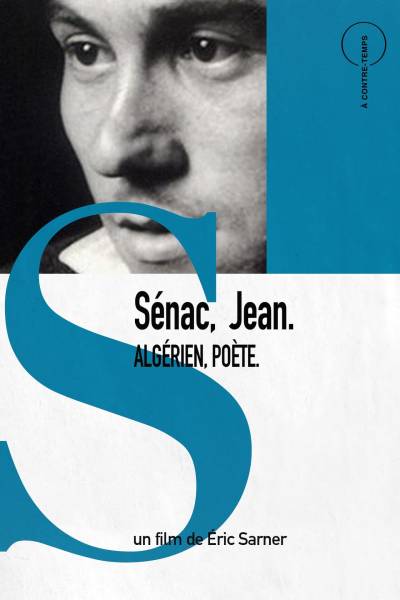 Sénac, Jean. Algérien, Poète.Moyen-métrage – 2011Jean Sénac, né à Béni Saf en Algérie en 1926 et mort à Alger en 1973, est aujourd'hui considéré comme l'un des grands écrivains et poètes fran…Jean Sénac est lié(e) à ce film en tant que poète
Sénac, Jean. Algérien, Poète.Moyen-métrage – 2011Jean Sénac, né à Béni Saf en Algérie en 1926 et mort à Alger en 1973, est aujourd'hui considéré comme l'un des grands écrivains et poètes fran…Jean Sénac est lié(e) à ce film en tant que poète -
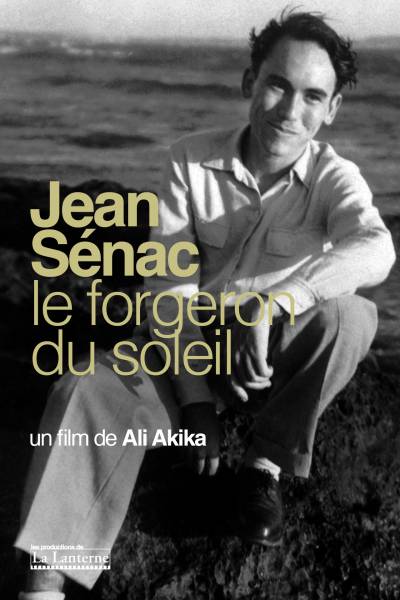 Jean Sénac, Le Forgeron Du SoleilMoyen-métrage – 2003"Jean Sénac, Le Forgeron Du Soleil" est un documentaire portrait de Ali Akika sur Jean Sénac, poète algérien d'expression française, né à Béni-Saf en …Jean Sénac est lié(e) à ce film en tant que personne concernée
Jean Sénac, Le Forgeron Du SoleilMoyen-métrage – 2003"Jean Sénac, Le Forgeron Du Soleil" est un documentaire portrait de Ali Akika sur Jean Sénac, poète algérien d'expression française, né à Béni-Saf en …Jean Sénac est lié(e) à ce film en tant que personne concernée -
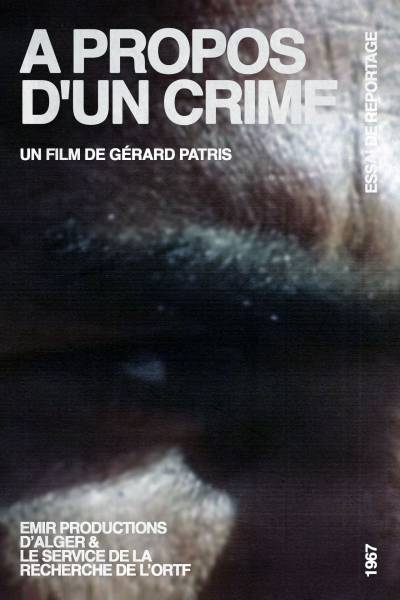 A Propos D’Un CrimeCourt-métrage – 1967En 1967, Visconti vint à Alger pour le tournage de l’Étranger avec Mastroianni et Anna Karina. Camus, de son vivant, avait toujours refusé qu’un de ses romans fût porté &agra…Jean Sénac est lié(e) à ce film en tant que poète
A Propos D’Un CrimeCourt-métrage – 1967En 1967, Visconti vint à Alger pour le tournage de l’Étranger avec Mastroianni et Anna Karina. Camus, de son vivant, avait toujours refusé qu’un de ses romans fût porté &agra…Jean Sénac est lié(e) à ce film en tant que poète
Partager :



